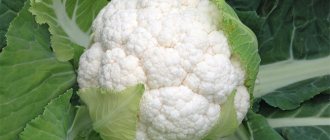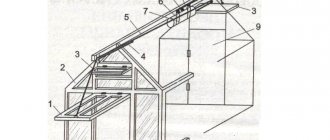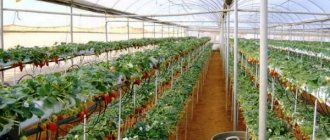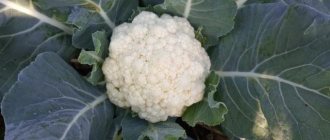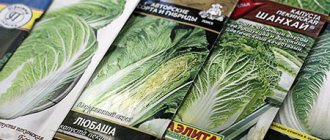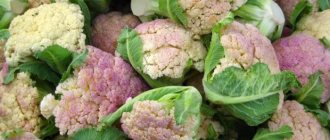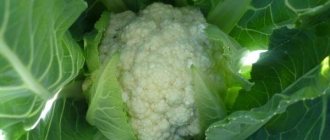From time immemorial, cabbage has been a favorite crop for summer residents, although it is quite capricious and constantly requires attention. It is from fresh cabbage that delicious, rich cabbage soup is obtained, and how healthy is the appetizer of sauerkraut with cranberries! The variety of cabbage varieties has increased the number of recipes for diligent housewives. Along with the traditional white cabbage, they grow Chinese, Savoy, cauliflower, Brussels sprouts, Beijing sprouts, and even broccoli, a storehouse of minerals and vitamins. It has long been noted that all cabbage varieties are very moisture-loving, but although they are not afraid of cold weather, low temperatures can destroy them. To ensure a generous harvest and tight heads of cabbage, it is advisable to grow cabbage in a greenhouse, where ideal conditions are created for the demanding vegetable.
Features of breeding early ripening varieties ↑
If you decide to choose “early ripening” for planting, you should pay attention to the most popular varieties among summer residents:
- “Number one K-206” grows in 120 days and gives a yield of 30-40 kg per 10 m². The heads of cabbage ripen at the same time, they are small in size, medium density, round in shape and weigh up to 2 kg. The leaves grow in a small rosette. The stump is short. The variety is recommended to be consumed fresh in salads. In areas of the north-west of the country, shooting is possible during a long spring.
“Number One” should be harvested on time, otherwise the heads of cabbage will become cracked and the quality of the product will decrease
- “Golden Hectare 1432” ripens 110-130 days from the moment the seedlings peck, a little later than “Number One”. A couple of weeks after the first formed heads of cabbage appear, the entire harvest can be harvested. This variety is not prone to cracking. The heads of cabbage are white, round in shape, of medium density, their weight reaches 3 kg. The socket is larger than that of “Number One”. Medium stump – 7-18 cm.
“Golden hectare 1432” is suitable for both fresh consumption and fermentation
- “Ditmarskaya Rannyaya” grows earlier than other varieties - 50-70 days after planting, and this is much earlier than “Number One”. It is distinguished by high marketability of heads of cabbage and uniform yield. The shape of the heads of cabbage is round, slightly flat, and the density is average. Average weight is one and a half kilograms. From 10 m² you can harvest 30-40 kg of crop.
“Ditmar early” and other early ripening varieties are recommended to be grown in greenhouses
Choosing the right seeds
Before purchasing seeds, you need to clearly define for yourself the purpose of the crop being grown: using cabbage in the summer diet or long-term storage of its reserves for the winter. The timing of sowing and the choice of cabbage variety will depend on this.
When choosing seeds, it is very important not to purchase expired material or seeds that have lost the ability to germinate due to improper storage. It is also important to know the criteria for choosing cabbage seeds for planting in a greenhouse
Basic criteria for choosing cabbage seeds:
- soil type;
- growing region;
- ripening time;
- resistance of the material to pests and infections;
- purpose of the crop being grown;
- resistance of heads of cabbage to cracking;
- place of selection (seeds must be grown in your climatic conditions).
Before purchasing seeds, it is important to ask the seller and study documents confirming the quality of the purchased products
Beijing cabbage in a greenhouse ↑
Chinese cabbage is early ripening, and planting it in a greenhouse guarantees very early ripening. Growing up, it forms a rosette from the leaves, in other words, a loose head of cabbage. After 20-40 days from the moment of germination, it is already possible to harvest.
It is recommended to harvest Chinese cabbage either right before eating or early in the morning, as it withers quickly
Seeds have the ability to germinate even at 4-5˚С, although the optimal growing conditions are 16-18˚С. Loose, fertile soil allows the root system to fully develop. Usually 1 or 2 g of seeds are sown per 1 m². Until the shoots appear, the temperature should be about 20˚C, then it is gradually reduced to 10˚C. Further, temperature indicators depend on the time of day: up to 16˚C at night and up to 22˚C during the day.
If seedlings are used for cultivation, then they are taken at 20 days of age and placed in the ground, taking into account a feeding area of 20x20 cm.
Note! Chinese cabbage is used in greenhouses to thicken tomatoes or cucumbers. In this case, the soil should be thoroughly fertilized, with 30 g of superphosphate, 4 kg of humus per 1 m², using ammonium nitrate and potassium chloride. During the growth process, 1 or 2 feedings are carried out with ammonium nitrate and potassium salt. The temperature regime remains the same as that of the main crop.
Soil preparation
The most suitable soil for planting cabbage is sandy loam. It is better to place greenhouses on a hill so that the soil dries out faster in the spring. This will speed up the start of the planting process.
Soil cultivation for planting cabbage should begin in the fall so that most soil pests do not survive the frosts. It’s good if cucumbers, onions, potatoes, carrots or legumes grew in this area before the cabbage, since many nutrients remain after them.
Cabbage requires loose sandy loam soil.
It’s bad if you don’t change the location of the previous planting of this vegetable, even if representatives of other varieties grew there last year. You cannot plant cabbage where radishes, lettuce and other cruciferous vegetables previously grew. Causative agents of various diseases and parasites that are equally harmful to these plants may remain in the soil.
All previous vegetation from the garden must be removed immediately after harvesting. Then the soil is dug up - the deeper the better. The topsoil layer should be about 20 cm. Simultaneously with plowing, you need to fertilize the soil. For this purpose, mineral preparations and various organic substances, such as manure or rotted contents of compost pits, are used.
Site preparation continues in the spring immediately before planting. If the soil is stale and hard, it needs to be dug up again. If the arable layer is not compacted, just loosen it.
Growing cauliflower ↑
Cauliflower is one of the most demanding crops. It requires not very high temperatures and high humidity, since in other conditions the formation of heads is disrupted.
The spaces between the rows of cauliflower are filled with dill, lettuce, radishes, sowing them in lines, the distance between which is 10 cm
The seedlings are placed in greenhouses in March or early April, planted in two rows, the distance between which is 60 cm. The age of the seedlings should not exceed 45 days, otherwise they will not take root well.
Regular plant care includes the following operations.
- Loosening the soil.
- Watering 2 times a week or more often.
- Fertilizing with mullein infusion, superphosphate, urea and potassium sulfate. After 10 days, the fertilizing is duplicated, and ammonium molybdate and boric acid are added. A similar procedure is repeated a third time. Between fertilizing, the soil should be loosened.
- Shading of the heads at the initial stage of their formation. For this purpose, two sheets are folded over the heads so that they do not darken.
- Protection from parasites. To get rid of cruciferous flea beetles, use a mixture of tobacco dust and lime. Cabbage flies, cutworms and white flies are driven out with ash and mothballs. When heads appear, spraying should be stopped.
The heads are harvested before they fall apart. By the way, healthy plants with powerful leaves can produce a second harvest if you carefully cut off the first head. Leave 1-2 strong shoots, the rest are not needed. Watering and fertilizing are carried out as usual. If you properly care for the plant, you can get heads weighing up to 500 g.
Planting and care
vegetable gardener can grow cabbage in a greenhouse The technology for growing early cabbage in a greenhouse is not complicated. It is enough to follow the rules and know some of the subtleties of caring for it. When to plant cabbage seedlings in a greenhouse?
Seeds are sown in the greenhouse in February, seedlings are planted in the greenhouse in mid-April . Some, the most daring specialists, sow seeds in December, illuminating the seedlings with phytolamps, and receive a harvest in early June.
Seeds
Even in a greenhouse, cabbage is grown only from seedlings . How to grow early cabbage seedlings in a greenhouse? To get strong seedlings, you need to choose and plant the seeds correctly. You should choose the largest and darkest ones.
Before planting, they must be treated - first 20 minutes in hot water (up to 50°C), then dipped in cold water for several minutes and dried. As a preventative measure for fungal diseases, they can be treated with a solution of nitrophoska .
Planting seeds
It is best to sow seeds for seedlings in steam beds or greenhouses. When growing cabbage seedlings in a greenhouse, biofuel is most often used. To prepare a steam bed, you need to dig a trench in the ground up to 30 cm deep and 100-120 cm wide. Biofuel is placed at the bottom and covered with earth on top. For seedlings, the most suitable substrate is made from equal parts of turf soil, peat and sand.
Seedling care
How to grow cabbage seedlings in an unheated greenhouse or under film? Seeds are planted in soil heated to 20°C to a depth of 1 cm. A frame with a film at least 30 cm high is installed on top. The first seedlings hatch within 4 days , which means that the greenhouse can be opened during the daytime to harden the seedlings. It is not yet recommended to water the seedlings. After the first leaf appears, the temperature should be raised by 2-3°C until it reaches 10-12°C.
When the first 1-2 leaves appear, the seedlings need to be thinned out and active watering and fertilizing of the seedlings should begin. During growth it is fed 3 times .
The first time they are fed with a mixture of phosphorus, potassium and nitrogen fertilizers, the second time - only nitrogen, and the third time - before planting the seedlings in the greenhouse - they are again fed with a nitrogen-potassium-phosphorus mixture. Watering is carried out daily in the morning .
Transplanting seedlings into a greenhouse
The most important thing is that you have already grown the seedlings. There is very little left, the main troubles are behind us. Before planting seedlings in the greenhouse, the soil is prepared. In addition, the greenhouse must be equipped with lamps for additional illumination.
Growing cabbage seedlings in a polycarbonate greenhouse is a proven method for creating optimal conditions, which is increasingly gaining popularity among gardeners and summer residents.
The soil
Cabbage is a plant that loves a lot of water, so the soil for it should be dense and retain moisture well. It’s better to start preparing it in the fall - dig it up properly, no less than a spade’s length, and at the same time apply fertilizer. This can be compost humus or manure and mineral fertilizers. Cabbage does not like acidic soils , so if necessary, liming should be done in the fall.
You cannot plant cabbage on the same land year after year. Crop rotation must be observed , otherwise you will not get a good harvest.
The best predecessors for it are cucumbers, potatoes, onions or legumes; after them, many useful substances remain in the ground.
Transplanting
Transplantation into the greenhouse is done when the sprouts have formed 4 leaves, it looks strong and has a green-purple color . If the sprouts are light green, this indicates their weakness and unreadiness for transplantation.
A few days before planting, the seedlings need to be hardened off a little . To do this, the daytime temperature in the greenhouse is reduced to 16-18°C, and the night temperature to 12°C. It is also regularly ventilated. It is better to survive seedlings by transshipment, without shaking off the earthen lump from the roots, so as not to damage them. A hole is made in the ground, watered with water and fertilizer.
A seedling is lowered into the hole, the earth around it is compacted tightly, which ensures maximum contact of the roots with the soil . There should be a distance of at least 30 cm between seedlings. Watering cabbage should begin a week after planting, when the seedlings have taken root well.
Care
Caring for cabbage in a greenhouse consists of regular watering, loosening the soil, fertilizing and maintaining temperature and light conditions. Cabbage is very light-loving ; the daylight hours for it should be 14-17 hours. If necessary, it needs to be illuminated.
The temperature for normal growth and maturation is maintained at 16-20°C. Once every 2 weeks, cabbage is fed with manure dissolved in water . The required humidity is 70-80%, watering should be regular and plentiful.
Growing broccoli in a greenhouse ↑
This plant can tolerate low temperatures, even frosts, so in the middle zone it is often planted in open ground, in beds. In non-Black Earth regions, broccoli seeds are sown in greenhouses as early as March. Shoots appear on the 3rd or 4th day, and after 10 days 3-4 true leaves grow.
Broccoli heads cut early in the morning last longer
If you take seedlings, then planting occurs at the end of April. The temperature in the greenhouse should not exceed 18˚C during the day and 12˚C at night. It is recommended to plant 35-40 day old plants with 5-6 true leaves.
It is important to properly prepare the area allocated for planting broccoli seedlings. Since the fall, it has been dug up, limed and fertilizers applied: 30 g of superphosphate, 5 kg of manure, 20 g of potassium salt, 25 g of ammonium nitrate - per 1 m². In spring, you can also effectively fertilize the soil; compost or humus, superphosphate, garden mixture, and ammonium nitrate are suitable.
Caring for broccoli is traditional: loosening, timely weeding, hilling, watering to a depth of 40 cm. Even before the flowers bloom, the central heads should be removed so that they do not become loose and tasteless. By cutting off the heads 10-20 cm in diameter, they also grab a 10-centimeter part of the stem, which is also edible. After 2-3 weeks, slightly smaller offspring mature - up to 6 cm.
Timely watering
The main principle of watering cabbage (both adult plants and seedlings) is that it needs to be watered as the soil dries out
However, it is important to remember that cabbage is a moisture-loving plant, so you should not allow the soil to become too dry. Excessive watering, in turn, can cause fungal and viral diseases.
Therefore, water should always be in moderation.
On average, cabbage seedlings are watered once every 7-10 days. After watering, the room in which the seedlings are located can be ventilated. However, remember that this culture is very afraid of drafts.
Important! Cabbage seedlings should not be watered with cold water. As in the case of soaking, the best water for irrigation is considered to be rain or melt water
It is good to water the cabbage with ordinary running water, passed through a filter and left for 1-2 days at room temperature.
Plant compatibility in the garden
In order for some crops to have a beneficial effect on their neighbors in the garden, experienced gardeners organize mixed plantings of vegetables.
Mixed plantings improve vegetable yields
It should be noted that you need to take into account some subtleties when choosing plants:
- the timing of ripening of different crops so that the soil is not bare;
- differences in height and development of the root system (deep, shallow);
- similar watering needs.
The best neighbors for cabbage are lettuce, peas, potatoes, corn, onions, cucumbers, parsley, leaf celery, radishes, melon, and spinach.
The best neighbors of cabbage are peas, lettuce, potatoes, etc.
I came across an article by N. M. Zhirmunskaya “Good and bad neighbors in the garden bed.” Having become interested in this topic, I spent a long time studying the subtleties and nuances of the issue. Then, for two years, I tried to apply this planting algorithm at my dacha. Not everything worked out right away as I would have liked. Today I can note that I learned how to plant plants by mixing different vegetables, flowers and herbs. Thus, I get combined plantings of main crops and additional ones, which create a favorable environment, increase resistance to disease and even affect the taste of the fruit. When using this method, the soil is protected from weeds and drying out, and the number of pests is significantly reduced, since the smell of strong-smelling neighbors repels insects. I plant lavender, marigolds, calendula, oregano, basil, sage, wormwood and peppermint along the edges of the beds and around the perimeter of the vegetable garden. In addition, it creates an ideal refuge for predatory insects, spiders and frogs that feed on pests. This does not mean that they disappear completely, the main thing is that they do not cause significant damage. Last year I was once again convinced that early cabbage and tomatoes, late cabbage and early potatoes, tomatoes and celery, beans and potatoes feel good next to each other. From the above, I can conclude that the main functions of using the correct neighborhood are:
- rational use of land;
- protection from diseases and pests;
- no soil depletion;
- increasing productivity.
You will have to work hard to create such beds, but the results will not disappoint you.
